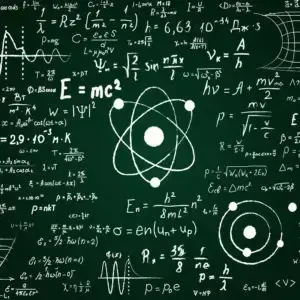Someone smarter than me, please go ahead and explain how this is going to be used to make life worse for all of us, probably in a deeply disturbing political reality that screams “the world Quinn from Sliders slid into and had to jump early because fuck this timeline”
It could actually be a good thing, since it opens up the possibility of unsnoopable channels of communication, using encryption that would be disrupted by any attempt to intercept it.
Also the ability to crack any of our current encryption almost instantly…
Quantum entanglement is different than quantum computing.
Not exactly; entanglement is a critical element of quantum computing for the encryption and decryption referenced.
Not what I understand. The encryption referenced is about having an immutably certain shared data source from entanglement that can be used as encryption/decryption input. Quantum computing does promise to crack current encryption technology in the future.
You sound quite miserable, maybe you should stop thinking like this
I thought the whole point of entangled communication is that you didn’t need to “send” anything. It automatically flips the entangled bit on the other end, all that “spooky action at a distance” bidness. Why do the need to “send” entangled photons?
You need to prep by sending the entangled particles (photons in this case). The spooky action is when you act on 1, you also act on the other. The useful bit is the uniqueness of the link. It cannot be intercepted without it being obvious and detectable.
Think of it like voodoo dolls. It works at a distance, but you need to make the voodoo doll using a bit of the target, then send/take it elsewhere to stab.
I’m pretty ignorant of physics, but isn’t it only certain kinds of ways of acting on the first particle that “affect” the other, namely actions that measure a property of one particle that is correlated with the same property’s value on the other? At first you don’t know the value of either but you know they’re correlated; but then when you measure and collapse the wave function on one and discovered a value for the property, you have automatically collapsed the wave function on the other too, yielding a predictably correlated value. If it were just any kind of action that affects the other particle, you’d be able to use it to sent information instantaneously, which you can’t do. So it’s not quite like how people imagine voodoo dolls: do something to the doll (make a change to it) and the person feels the effect. But perhaps someone who studies this stuff can help clarify.
That’s fairly close. The only proviso is there are some ways to affect the results. You can’t send actual information along the link, but you can prove they were in communication. That proof requires information from the sending end however. It’s only provable once that information is sent. Basically they communicate faster than light, but can’t send information faster than light. Entanglement is weird.
I’ve heard this explanation of it once from a physicist: Imagine you have a photograph. You rip that photograph in half. Now you put both halves into envelopes and mix them up. At this point, you don’t know which half is in which envelope. Now you send one of the envelopes to Australia. You open your half. Because you see that you have the left half of the photograph, you gain instant knowledge that the right half is in Australia.
With quanta, you can for example have a subatomic particle which decays into two quanta and then you know those quanta to have certain similar properties. As Wikipedia puts it:
For instance, a spin-zero particle could decay into a pair of spin-1/2 particles. If there is no orbital angular momentum, the total spin angular momentum after this decay must be zero (by the conservation of angular momentum). Whenever the first particle is measured to be spin up on some axis, the other, when measured on the same axis, is always found to be spin down.
https://en.wikipedia.org/wiki/Quantum_entanglement#Meaning_of_entanglementare the ripped photographs duplicates since changes on one effects the other im confused, like does ripping create two of the same
Right, so you might want ask about this on [email protected] or such, as science-y folks tend to not be comfortable with what I’m about to say, but to the best of my knowledge, that’s all just complete horseshit. Like, no, your understanding of the photograph is not somehow incorrect. It’s just two halves of a photograph and because you know the first half, you know what’s on the second half. The second half does not get changed by you looking at the first half. Nor does the entangled quantum get changed by you looking at the first quantum.
I think, a big part of this mass confusion is that at the size that quanta have, looking at them does actually change/move the quantum that you look at (not a potentially entangled one). This is not for crazy reasons, but because looking at them requires light, which is the equivalent of blasting them with photons, and photons are themselves quanta.
It’s like if you had a dark room with a ball in it and you can only throw other balls into there to try to figure out where the first ball is. You need to hit the first ball, in order to have a chance of working out where it might be based on the angle that your thrown ball returns at. If you do hit the first ball, it will move. So, you only really know where it was at the time of impact. Quanta are not balls, but they do still interfere with each other when they get close to each other.Entanglement in this analogy is that you’ve spun up two balls next to each other like cogwheels, so you know them to have the opposite (and equally strong) spin. Then you’ve released those into the dark room and start throwing other balls at them to try to work out their spin. If you hit one of the spinning balls, your thrown ball will come back out with a spin opposite to that and the spin of the ball that was hit will have reduced. In this moment, you know that the other spinning ball also has an opposite spin, because you originally spun the two balls like cogwheels. The other ball does not get changed by you measuring the first, but there’s no way for you to know, because you have to measure it to find out, which means also throwing a ball at it and therefore changing it, too.
As far as I can tell, this is the other big part of where the confusion comes from. Because measuring necessarily also involves changing the thing and because it’s actually impossible to disprove that the entangled quantum didn’t get changed by us measuring the first, you get folks that follow a school of thought of things being non-deterministic. Of things only being set in stone once you measure them. There’s lots of vested interest in things being non-deterministic for religious or moral reasons and there is no way to disprove it at the quantum level. These folks then propagate concepts like superposition and that when you open the box, you’re the one that forces the cat to be killed. (Schrödinger was not one of them, by the way. The cat analogy was a critique of superposition as an idea.)
To my knowledge, there’s no evidence for non-determinism (folks will sometimes argue with quantum fluctuation showing it, but it doesn’t happen in complete isolation, so that disqualifies it in my opinion) and given that the rest of our reality seems to be perfectly deterministic, I think we should assume the quantum stuff to be like that, too, unless proven otherwise, but unfortunately not everyone goes along with that.
Quantum physicist here. Your idea is effectively correct, but the issue lies in generating entanglement at a distance, which is a gargantuan task. You can’t start with two qubits (in the current discussion the photons are qubits, holders of quantum information) and simply proclaim them to be entangled over long distances (even centimeters can be considered long in the quantum realm). One of the more promising methods to achieve entanglement at a distance is to create entangled photons locally in your friendly neighborhood lab, and send them on their merry way. Photons are incredibly good at travelling far. When they have reached their destination you are free to do the next complicated part, the ‘spooky action at a distance’ as you call it ;) I just call it magic.
The two standardized method of sending photons over earthly distances is either a) via air (e.g., lasers, radiowaves or satellite communication) or b) via fibre optics. Since the fibre optics network is so developed across the globe, quantum information engineers would love to tap into that infrastructure - which is the main motivation for the work done in the main article. Here, they proved that the entanglement survives the journey through the optical cable, which was expected (but not a given) for short distances. Entanglement is sensitive business and is lost very easily. 30 km of travel through an optical cable can be considered very, very long based on these premises - but also around the upper limit of what can be achieved without significant advances of quantum repeaters which replaces the functionality of amplifiers in traditional optical fibre networks.
The “spooky action” is really just the determination of a particle’s spin on one side meaning you already know the other particle will have an opposite spin. This probably violates locality because you gain knowledge about something that’s non-local from a quantum perspective, even though entangled particles have to start local (there are opposing interpretations, like the de Broglie-Bohm). While in fiction this might suggest that changing the state of one particle simultaneously changes the other, in real life this just means extra information you mathematically shouldn’t have, and doesn’t really lead to FTL information transmission. What it does mean is that if you want secure communications you can use entangled particles to generate a secret key, determining the spin of them on either side, and you can be sure that they haven’t been tampered with and that the other side of the communication will be equal and opposite. It’s essentially a one-time pad.
TLDR: Researchers were able to send and receive entangled photons over a fiber optic cable that was simultaneously carrying a classical (non-quantum) signal typical of high speed telecommunications. They managed to accomplish this without the classical signal significantly interfering with the quantum measurements.
This was all done in a laboratory using a combination of standard telecommunications equipment for the classical signal and specialized equipment for the quantum signal. It was NOT done on a fiber carrying real internet traffic as the article would suggest.
IIUC, quantum entanglement at a distance provides for faster than light/instant communication of state changes. High frequency trading, and dark orderbooks, is the only known economic application (space communications a far off application). I’m not sure why article avoided talking about this purpose.
You don’t understand correctly. Entangled particles do not allow for faster than light communication.
While the entangled photons may be thought of as changing state simultaneously, in practice, it’s not possible to use this to convey information, as doing so would break causality, and effect would be able to happen before its cause. Remember that what is commonly termed ‘the speed of light’ is actually better expressed as ‘the speed of causality’. The most useful application of what this experiment performed would be in the area of quantum cryptography.
So honest question here:
Why can’t it be used to transmit information? Wouldn’t we be able to capture the state and use that be turned into instructions the same way we use binary currently?
Binary is essentially just a series of “on” and “off” states that we capture and translate into instructions, so why can’t we do that with entangled particles? Like position 6 translates into instructions F and position 2 triggers instructions B.
I know this is overly simplified but I do not follow that we can’t send information this way when looking at it through this lense.
Watch these videos that explain the answer. Basically, the problem is that you can only use this to convey random information , which would be indistinguishable from not sending anything at all.
Correct, but still amazing because it means quantum internet is achievable over existing infrastructure. Not needing to lay down all new lines around the world for quantum transmissions will mean it gets adopted much faster. Even if specialized equipment is needed on either end of the cable, the hope/assumption would be that specialized equipment on either end will become cheaper as tech advances and scales upward - still a long ways off but cut down significantly.
There are still massive hurdles for using optical fibre networks for quantum information transmission. The biggest lies in attenuation, where information is lost as the optical signal traverses the fibre. This is an exponential decay, so the signal is lost very quickly for longer distances. This is also the case for normal fibre communication, but these signals can be amplified using conventional amplifiers (aka repeaters in some fields), which are conveniently placed every 80 km or so in order to boost the signal. In contrast, quantum states can not be amplified in a similar manner and have to rely on quantum repeaters which, well, are more of a theoretical concept at this point in time.
So, while the specialized equipment you refer to is indeed needed at both ends, the real challenge still lies in the quantum repeaters. Fortunately, satellite based communication is not as heavily punished by attenuation and would require fewer repeating steps (as compared to fibres) to transmit a quantum state from one end of the globe to the other. A handful of few repetition steps is a lot less daunting then the several hundreds that would be required for globe-scale quantum transmissions via fibre.




